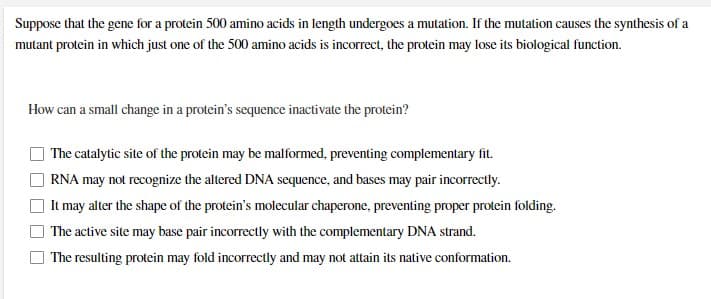Suppose that the gene for a protein 500 amino acids in length undergoes a mutation. If the mutation causes the synthesis of a mutant protein in which just one of the 500 amino acids is incorrect, the protein may lose its biological function. How can a small change in a protein's sequence inactivate the protein? The catalytic site of the protein may be malformed, preventing complementary fit. RNA may not recognize the altered DNA sequence, and bases may pair incorrectly. It may alter the shape of the protein's molecular chaperone, preventing proper protein folding. The active site may base pair incorrectly with the complementary DNA strand. The resulting protein may fold incorrectly and may not attain its native conformation.
Suppose that the gene for a protein 500 amino acids in length undergoes a mutation. If the mutation causes the synthesis of a mutant protein in which just one of the 500 amino acids is incorrect, the protein may lose its biological function. How can a small change in a protein's sequence inactivate the protein? The catalytic site of the protein may be malformed, preventing complementary fit. RNA may not recognize the altered DNA sequence, and bases may pair incorrectly. It may alter the shape of the protein's molecular chaperone, preventing proper protein folding. The active site may base pair incorrectly with the complementary DNA strand. The resulting protein may fold incorrectly and may not attain its native conformation.
Biology (MindTap Course List)
11th Edition
ISBN:9781337392938
Author:Eldra Solomon, Charles Martin, Diana W. Martin, Linda R. Berg
Publisher:Eldra Solomon, Charles Martin, Diana W. Martin, Linda R. Berg
Chapter13: Gene Expression
Section13.4: Translation
Problem 3C: A certain mRNA strand has the following nucleotide sequence: 5AUGACGUAUAACUUU3 What is the anticodon...
Related questions
Question

Transcribed Image Text:Suppose that the gene for a protein 500 amino acids in length undergoes a mutation. If the mutation causes the synthesis of a
mutant protein in which just one of the 500 amino acids is incorrect, the protein may lose its biological function.
How can a small change in a protein's sequence inactivate the protein?
The catalytic site of the protein may be malformed, preventing complementary fit.
RNA may not recognize the altered DNA sequence, and bases may pair incorrectly.
It may alter the shape of the protein's molecular chaperone, preventing proper protein folding.
The active site may base pair incorrectly with the complementary DNA strand.
The resulting protein may fold incorrectly and may not attain its native conformation.
Expert Solution
This question has been solved!
Explore an expertly crafted, step-by-step solution for a thorough understanding of key concepts.
This is a popular solution!
Trending now
This is a popular solution!
Step by step
Solved in 2 steps

Recommended textbooks for you

Biology (MindTap Course List)
Biology
ISBN:
9781337392938
Author:
Eldra Solomon, Charles Martin, Diana W. Martin, Linda R. Berg
Publisher:
Cengage Learning

Biology (MindTap Course List)
Biology
ISBN:
9781337392938
Author:
Eldra Solomon, Charles Martin, Diana W. Martin, Linda R. Berg
Publisher:
Cengage Learning